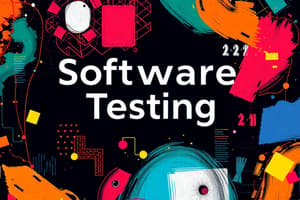Podcast
Questions and Answers
Which of the following statements best describes the relationship between testing and the software development life cycle (SDLC)?
Which of the following statements best describes the relationship between testing and the software development life cycle (SDLC)?
- Testing primarily focuses on installation and checkout phases of the SDLC.
- Testing is a distinct phase that occurs only after development is complete.
- Testing is an isolated activity, independent of the SDLC model.
- Testing is integrated throughout the SDLC, with activities corresponding to each development stage. (correct)
According to the IEEE standard, which sequence accurately represents the phases included in a typical software development cycle?
According to the IEEE standard, which sequence accurately represents the phases included in a typical software development cycle?
- Requirements, design, implementation, testing (correct)
- Concept, design, implementation, maintenance
- Planning, execution, monitoring, closure
- Analysis, coding, testing, deployment
What is the primary difference between a software development cycle and a software life cycle, as defined by IEEE Std 610.12 1990?
What is the primary difference between a software development cycle and a software life cycle, as defined by IEEE Std 610.12 1990?
- There is no discernable difference; the terms are interchangeable.
- A software development cycle focuses on the period until software delivery, while a software life cycle extends until the software is no longer in use. (correct)
- A software life cycle includes only the development and testing phases, while a software development cycle includes all phases from conception to retirement.
- A software development cycle is an older term, whereas software life cycle is the modern term.
In software development, what is the key benefit of adopting a process model?
In software development, what is the key benefit of adopting a process model?
Which testing practice is most aligned with effective software development, regardless of the specific model used?
Which testing practice is most aligned with effective software development, regardless of the specific model used?
What is a defining characteristic of a sequential development model?
What is a defining characteristic of a sequential development model?
In the Waterfall model, what is the primary implication of its limited guidance on handling changes during development?
In the Waterfall model, what is the primary implication of its limited guidance on handling changes during development?
In the V-model, what is the relationship between the development and testing phases?
In the V-model, what is the relationship between the development and testing phases?
Which of the following is a key challenge associated with iterative and incremental development models regarding testing?
Which of the following is a key challenge associated with iterative and incremental development models regarding testing?
In Agile development, what is emphasized over comprehensive documentation?
In Agile development, what is emphasized over comprehensive documentation?
Flashcards
Software Development Cycle
Software Development Cycle
The period from deciding to develop software to its delivery, including requirements, design, implementation, testing, and checkout.
Software Life Cycle
Software Life Cycle
The entire lifespan of a software product from conception to when it is no longer available for use, including concept, requirements, design, implementation, testing, operation, maintenance, and retirement phases.
Software Process Model
Software Process Model
An abstract representation of a process showcasing a description from a particular perspective.
Sequential Development Model
Sequential Development Model
Signup and view all the flashcards
Waterfall Model
Waterfall Model
Signup and view all the flashcards
Component Testing
Component Testing
Signup and view all the flashcards
Integration Testing
Integration Testing
Signup and view all the flashcards
System Testing
System Testing
Signup and view all the flashcards
Acceptance Testing
Acceptance Testing
Signup and view all the flashcards
Incremental Development Model
Incremental Development Model
Signup and view all the flashcards
Study Notes
- Testing happens throughout the software development life cycle (SDLC)
- Testing is part of a software development lifecycle model
- Different forms of testing exist in levels and types
- The life cycle model impacts testing significantly
Software Development Cycle
- Period from deciding to develop software to when it is delivered
- Includes requirements, design, implementation, test, and sometimes installation/checkout phases -Phases may overlap or iterate depending on the approach used
- Sometimes used to describe a longer period that includes when the software is no longer enhanced or its entire life
Software Life Cycle
- The period from when a software product is conceptualized until it is no longer usable
- Includes concept, requirements, design, implementation, test, installation/checkout, operation/maintenance, and sometimes retirement phases -Phases may also overlap or iterate
Software Development Models
- A software process model presents a description of a process from a specific perspective
- Important testing characteristics
- Every development activity has a corresponding test activity
- Each test level has specific test objectives
- Test analysis and design should start during the corresponding development activity
- Testers should help define/refine requirements and design
Sequential Development Models
- A software development lifecycle model where a system develops linearly through discrete, successive phases without overlap
- Examples: Waterfall, V-model
Waterfall Model
- One of the first process development models
- Best for well-understood problems with minimal or no requirements changes
- Simple to explain to customers
- Presents a high-level view of the development process as a sequence of activities
- Phases are marked by milestones and deliverables (artifacts)
Strengths and Drawbacks of the Waterfall Model
- Strengths
- Simplifies process
- Provides well documented phases to clarify decisions, create audit trails, and concrete milestones
- Drawbacks:
- Lacks guidance on handling changes during development, assuming frozen requirements
- It has no iterative activities for creating a final product
V-Model
- Includes four test levels
- Component, integration, system, and acceptance testing
- Test level: Specific instantiation of a test process
- Iterative models start with a product and refine it
- Incremental models complete one piece at a time
Iterative and Incremental Development
- Incremental development model: Component/system developed through increments
- Iterative development model: Component/system developed through repeated cycles
- Iterative and incremental models issues:
- Need for more regression testing
- Defects outside the scope of an iteration/increment
- Less thorough testing
RUP (Rational Unified Process)
- Example of incremental and iterative development
- Involves four steps
- Inception
- Elaboration
- Construction
- Transition
Scrum
- An iterative and incremental framework for effective team collaboration used in Agile development
- Uses small Teams
- Consists of key roles:
- The Product Owner
- The Development Team
- The Scrum Master
Kanban Board
- The Kanban system originated in manufacturing at Toyota
- Principles
- Limits for activities
- Strong focus on customer needs
Spiral Model
- Risk-based model
- Involves four steps:
- Determine objectives
- Identify risks and alternatives
- Develop and test
- Plan the next iteration
Agile Development
- It is a group of software development methodologies
- Uses teams of around 5 to 9 people
- Agile Manifesto (2001) values:
- Individuals and interactions over processes and tools
- Working software over comprehensive documentation
- Customer collaboration over contract negotiation
- Responding to change over following a plan
Agile; Benefits for Testing
- Focuses on good quality code
- Includes testing with self-organizing teams
- Has accessibility of business stakeholders and a simplicity of design
Agile; Challenges for Testing
- New test basis needing different kinds of testers
- There is a perception that testers are not needed because of constant time constrains and complicated testing
SDLC Models
There is not a "best" model, most suitable model depends on
- The project goal, type of product being developed, business priorities or and risk
Commercial off-the-shelf (COTS)
- A type of product developed in an identical format for a large number of customers in the general market.
Studying That Suits You
Use AI to generate personalized quizzes and flashcards to suit your learning preferences.




